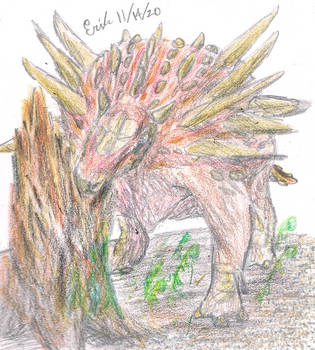ShopDreamUp AI ArtDreamUp
Deviation Actions
Description
It's map ti~ime.
This is an extremely preliminary map of the environs of my new story, with major land forms and climate zones sketched in.
The landforms come from ([link]), and the climate sketches come from good old-fashioned research (mostly Plants and the K-T Boundary by Nichols and Johnson and wikipedia). The climate zones are:
Teal: Frenchman formation
cypress forests
Blue: Horseshoe formation
floodplains, channels, and coal swamps
brackish estuaries
Red: Wiliston Basin/Hell Creek Formation
rivers, deltas, and swamp
mild, sub-tropical climate, palms and crocodiles
Yellow: Powder River Basin/Lance formation
warm, heavy rain
Orange: Wasach Plateau/Horn Mountain Formation
Lakes, large rivers
Purple: Denver Formation
Rainforests
Green: Raton Basin
Coal forests, silt Fluvial coastal plain, Warm sub-humid
broadleaf evergreens (jungle if not rainforest)
So moving from north to south down the west coast of the Interior Seaway, it looks like we have a spectrum of tempret-subtropical-tropical forests and swamps, very wet, with heavy rainfall. I suppose the eastern half of North America would be drier, but I don't know of any Maastrichtian fossils sites from that part of the continent.
So first of all, do I have my facts strait? Are these really the most likely environments in the right places?
Second, if I am right, what does this mean for the cultures of the descendants of our time-traveler friends ([link])? As a settled culture I'm thinking of a series of city-state colonies of a Thalassocracy based on the north coast. Think the Srivijaya Empire ([link]). These guys will have colonial city states around the Seaway, with walled trading towns on the rivers that extend into the subtropical rainforest. The inhabitants of the rainforest are nomadic hunter-gatherers, slash-and-burn agriculturalists, and the Commensals, who lash their villages to the backs of hadrosaurs and ride the herds from one end of the migration rout to the next. Think Yanomamo/Mongols.
So, any thoughts? Is all this plausible (assuming the fact of time-travelling humans settling the Maastrichtian world)?
Edit: added some formations and removed some others as anachronistic. The presence of marine deposits HERE rather than THERE tells us something about the shape of the Seaway (which could just as easily have extended north from the Gulf of Mexico but which for plot reasons I have extending south). I also added some info from Jobaria's project: [link]
This is an extremely preliminary map of the environs of my new story, with major land forms and climate zones sketched in.
The landforms come from ([link]), and the climate sketches come from good old-fashioned research (mostly Plants and the K-T Boundary by Nichols and Johnson and wikipedia). The climate zones are:
Teal: Frenchman formation
cypress forests
Blue: Horseshoe formation
floodplains, channels, and coal swamps
brackish estuaries
Red: Wiliston Basin/Hell Creek Formation
rivers, deltas, and swamp
mild, sub-tropical climate, palms and crocodiles
Yellow: Powder River Basin/Lance formation
warm, heavy rain
Orange: Wasach Plateau/Horn Mountain Formation
Lakes, large rivers
Purple: Denver Formation
Rainforests
Green: Raton Basin
Coal forests, silt Fluvial coastal plain, Warm sub-humid
broadleaf evergreens (jungle if not rainforest)
So moving from north to south down the west coast of the Interior Seaway, it looks like we have a spectrum of tempret-subtropical-tropical forests and swamps, very wet, with heavy rainfall. I suppose the eastern half of North America would be drier, but I don't know of any Maastrichtian fossils sites from that part of the continent.
So first of all, do I have my facts strait? Are these really the most likely environments in the right places?
Second, if I am right, what does this mean for the cultures of the descendants of our time-traveler friends ([link])? As a settled culture I'm thinking of a series of city-state colonies of a Thalassocracy based on the north coast. Think the Srivijaya Empire ([link]). These guys will have colonial city states around the Seaway, with walled trading towns on the rivers that extend into the subtropical rainforest. The inhabitants of the rainforest are nomadic hunter-gatherers, slash-and-burn agriculturalists, and the Commensals, who lash their villages to the backs of hadrosaurs and ride the herds from one end of the migration rout to the next. Think Yanomamo/Mongols.
So, any thoughts? Is all this plausible (assuming the fact of time-travelling humans settling the Maastrichtian world)?
Edit: added some formations and removed some others as anachronistic. The presence of marine deposits HERE rather than THERE tells us something about the shape of the Seaway (which could just as easily have extended north from the Gulf of Mexico but which for plot reasons I have extending south). I also added some info from Jobaria's project: [link]
Image size
1308x1328px 513.87 KB
© 2011 - 2024 bensen-daniel
Comments30
Join the community to add your comment. Already a deviant? Log In
Great map and concept, but isn't the Denver Rainforest a Paleocene rather than Maastrichtian development? I have no doubt that there were extensive jungles in the Late Cretaceous (in fact, I recall reading a couple of papers identifying rainforest vegetation in some Mexican formations from the late Campanian through early Maastrichtian), but I would be careful before extrapolating Paleocene biomes into the Cretaceous.




























